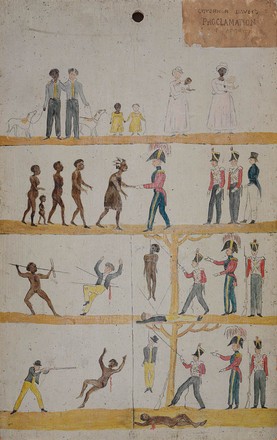
Governor Davey’s Proclamation to the Aborigines, 1816
Oil on board
SAFE / R 247
Purchased from J.W. Beattie, May 1919

Oil on board
SAFE / R 247
Purchased from J.W. Beattie, May 1919
There were several motivations to settle Van Diemen’s Land, including: to prevent the French from settling there; to procure natural resources; and to promote various industries.
Approximately 100 Proclamation Boards, oil on Huon pine, were produced. Of these, there are seven known surviving Boards in collections today (five of these are in Australia).
Van Diemen’s Land was settled as a colony of New South Wales in 1803. The island state seceded from New South Wales in 1825 and was renamed Tasmania in 1856.
First Contact was an emotionally, intellectually, physically and spiritually confronting series of encounters for the Indigenous inhabitants.
The images on the Proclamation Board have inspired numerous derivatives, such as: lantern slides; lithographs; postcards; book covers; and pottery.
The Mitchell Library Board was purchased from J.W. Beattie in May 1919 for £30, which is approximately $2,200 today.
The colonisation of Tasmania was a particularly violent time in Australian history; the period is often referred to as the Black War.
The intensity with which colonists pursued ‘claims’ for food, land and water, quickly transformed amicable relationships, with the Aboriginal peoples, into hostile rivalries.
The central image on the Board shows a conciliatory handshake, one between leaders representing the British and the Aborigines.